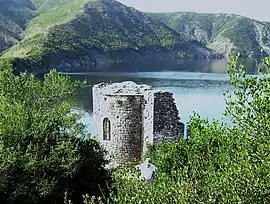Shurdhah Island
Shurdhah Island (Albanian: Ishulli i Shurdhahit) is an island in northern Albania. Shurdhah Island is located in the Vau i Dejës Reservoir, which is fed and drained by the river Drin. It is the largest island in the reservoir with an area of 7.5 hectares. From the most northern tip of the island to the most southern tip of it, it has an estimated length of 390 m (1,280 ft). It is mainly covered by trees. It is accessible by tourist boat in summer from the Vau i Dejës dam or Rragam.
 Medieval church ruins | |
| Geography | |
|---|---|
| Coordinates | 42°04′12″N 19°39′11″E |
| Area | 0.075 km2 (0.029 sq mi) |
| Highest elevation | 290 m (950 ft) |
| Administration | |
Albania | |
Etymology
The name of the original Illyrian settlement was Sarda (Albanian Sardë, Greek Sardoniki). Later, the name was changed to Shurdha which means 'deaf' in Albanian. The name changed while Albania was an Atheist Communist state, when due to the strong religious connection of the island, it was forgotten.
History
Sarda was founded between the 6th and 7th centuries. The town was strategically located on the old road from the Adriatic Sea to Dardania and served as a resting point along the trade route.[1] The settlement originally had a wall encircling the entire hill it was built on. Encircled on three sides by the Drin river, Sarda had 12 towers of various forms.[1] Sarda seems to have been a modest settlement from its foundation to the 9th century when it saw rapid expansion.[2] It gained its highest importance in the 12th century, when it was the seat of the joint bishop of Sapa and Sarda. In the 13th century Sarda had territorial disagreements with Scutari.[3]
The island was the original settlement of the feudal Lekë Dukagjini patriarch, famous for the rules of the Kanun.[4] It was ravaged by the Ottomans in 1491.[5]
In 1973, when the dam was completed, the city of Sarda became an island on the left bank of the river Drin.
Ecclesiastical history
Around 1100 a Diocese of Sarda was established on the island. No residential incumbents available.
The see of Sardë shortly comprised also the Diocese of Dagnum (Dagno, Daynum, Danj; Daynensis), founded as suffragan of Archbishopric of Antivari (now Bar, in Montenegro) during the second half of the fourteenth century, which was united with Sarda by Pope Martin V in 1428.
The bishopric of Sardë (Sardoniki) itself was suppressed no later than 1600, allegedly in 1491 when Pope Innocent VIII joined it to the Diocese of Sapë (Sappa), and the united sees were suffragans in the ecclesiastical province of the Metropolitan Archdiocese of Antivari until the end of the eighteenth century.
Titular see
In 1933 the diocese was restored as Titular bishopric of Sarda. The title has been held by:
- Luis Baldo Riva, Redemptorists (C.SS.R.) (1969.03.13 – 1978.01.15) as Auxiliary Bishop of Trujillo (Peru) (1969.03.13 – 1977.06.27), later Bishop-Prelate of Territorial Prelature of Chuquibamba (Peru) (1977.06.27 – death 1983.06.27)
- Roland Pierre DuMaine (1978.04.24 – 1981.01.27) as Auxiliary Bishop of San Francisco (California, USA) (1978.04.24 – 1981.01.27); later Bishop of San Jose (USA) (1981.01.27 – retired 1999.11.27)
- François Xavier Nguyễn Văn Sang (85) (1981.03.24 – 1990.12.03) as Auxiliary Bishop of Hà Nôi (Hanoi, Vietnam) (1981.03.24 – 1990.12.03); later Bishop of Thái Bính (Vietnam) (1990.12.03 – retired 2009.07.25)
- Titular Archbishop Ramiro Moliner Inglés (1993.01.02 – present)
Tourism
One can visit the ruins of the 11th-century medieval castle, which includes two rings of defensive walls and towers (some sadly submerged in the lake), the remains of a Byzantine church and other early medieval walls. The setting on the steep rocks rising from the lake is especially impressive.
References
- Aleks Buda (1984). Problems of the formation of the Albanian people, their language and culture: conference (selection). p. 89.
Sarda (Shurdhah) began its existence as a castle in the 6tb-7th centuries, not far from an important road which linked the Adriatic coast with the Dardan hinterland (Kosova). In the first period it had a wall encircling the entire hill (encircled on three sides by the Drin River) and 12 towers of various forms.
- Anthony Cutler; Arietta Papaconstantinou (17 December 2007). The Material and the Ideal: Essays in Medieval Art and Archaeology in Honour of Jean-Michel Spieser. BRILL. p. 55.
- Anamali, Skender (2002). Historia e popullit shqiptar. Botimet Toena. p. 225.
- Jubica, Irhan. "Shkodra, vendi i gjenezës" (in Albanian). Albanian Travel Magazine. Retrieved March 12, 2012.
- Elsie, Robert (2010). Historical dictionary of Albania. Plymouth: Scarecrow Press. p. 396. ISBN 978-0-8108-6188-6.